Reserve Bank of Australia Annual Report – 1991 Banking and Currency Operations
In addition to the policy-related operations discussed in earlier chapters, the Bank offers specialised services to a limited range of customers, consistent with its role as a central bank. These operations include banking and registry services, gold loans, note issue and currency distribution. The Bank aims to provide these services as efficiently as possible and at a competitive price.
Banking
As the central bank, the Bank is the primary banker to the Australian public sector. In 1990/91, it continued to provide specialised banking services through its branches to the Commonwealth Government, several State Governments, and a number of Commonwealth and State instrumentalities. The Bank also conducts accounts for other banks, authorised dealers in the short-term money market, and some overseas central banks and international monetary organisations.
The Bank is continuing to improve the services it gives its government customers. This has been assisted by the recent upgrading of its central computer processing capacity. In conjunction with the Commonwealth Government, the Bank is also developing a new, high-volume, direct-entry system (Gateway) and high-speed data links (RBAnet) between the Bank and other arms of government on the one hand, and the Bank and the full range of financial institutions on the other. This service is designed to provide a single point of entry for large volume Commonwealth payments (such as pensions) and, in time, for revenue collections. These arrangements are expected to see the Bank processing in excess of 130 million electronic transactions annually by 1992. Paper cheque clearance by the Bank, which increased substantially after the return of the Health Insurance Commission business in 1987, is likely to decline sharply as greater use is made of electronic funds transfers.
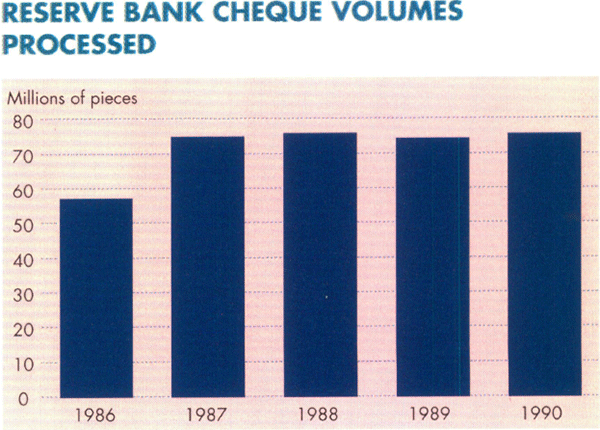
PC-based electronic desk-top banking known as ReserveLink, has been developed and provided to several of the Bank's customers. ReserveLink provides access to all account data and to electronic payments and collections.
With changes to the Bank's computer operations, all Commonwealth registry accounting is to be centralised during the course of 1991/92. Counter services will continue unchanged at the Bank's eight branches. However, inter-registry transfers will no longer be required; this will reduce costs, improve trading efficiency and allow better reconciliation procedures for the Commonwealth Government.
The Bank has been approached by a number of participants in the financial market with the view to reducing the period during which registry books are closed prior to the payment of interest or redemption proceeds. Consideration is being given to introducing a seven-day closed period for both interest and principal payments.
The Bank now conducts stock registries on behalf of several State Governments and other government bodies, as well as for the Commonwealth. The sophistication of the Bank's registry system allows the accommodation of both large and small registry business. A “one-stop” registry service is available using Austraclear links to enable customers' lodgment and uplift transactions in Austraclear's fixed interest system to be settled at the Bank's registries. For Commonwealth Government securities, the Bank has recently introduced its own computerised recording and settlement system – the Reserve Bank Information and Transfer System (RITS).
The Bank is represented in the Provider Advisory Group to the Cash Transaction Reports Agency which meets periodically to discuss practical problems experienced by financial institutions in the implementation of the requirements of the relevant legislation. As a cash dealer, the Bank is subject to the reporting and, for banking business, the account-opening provisions of the Act.
Gold
The Bank holds approximately 250 tonnes of gold as part of Australia's international reserves. In recent years, it has taken the opportunity to earn additional revenue through participation in the gold loan market. With gold production in Australia at high levels, there has been generally strong demand from producers for gold-denominated loans, and for facilities to allow them to hedge returns from future production. The Bank is not directly involved in these activities but, by providing loans at the wholesale level, it facilitates the operations of participating institutions. During 1990/91, the Bank dealt with eight separate counterparties and had loans of 30 tonnes outstanding at the end of June, compared with 17 tonnes twelve months previously. All loans made by the Bank are subject to stringent security conditions. The Bank derived income of almost $4 million from this activity during the year.
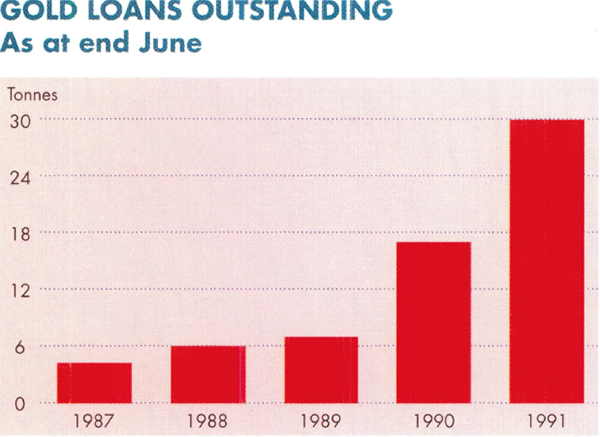
Note Issue and Currency Distribution
The Reserve Bank is the sole issuing authority for Australian currency notes. These notes are printed by Note Printing Australia, a division of the Reserve Bank, at Craigieburn in Victoria. The Bank manages the issue, distribution, processing and destruction of currency notes through its Currency and Banking Department. Responsibility for the day-to-day operations lies with the Bank's branches. The Royal Australian Mint in Canberra is responsible for the design and minting of Australia's coins. This coinage is then sold to the Reserve Bank which distributes it according to demand.
Money is held by Australians in various forms, most commonly as deposits with financial institutions or as cash. During June 1991 the relative aggregates were:
| $Billion | |
|---|---|
| Deposits with banks | 188.4 |
| Deposits with other financial institutions | 63.8 |
| Currency | 14.6 |
| Total | 266.8 |
The amount of currency on issue depends mainly on how much of its wealth the community chooses to hold in cash; the Bank seeks to meet that demand. Determining new note requirements involves estimating the number of notes of each denomination that the public is likely to demand at any given time. The average life of each denomination and growth in circulation are important factors in this process. Consideration also has to be given to the differing usage patterns (e.g. denomination preferences) in various parts of Australia. Changes in circumstances, such as banks switching to different denominations for their automatic teller machines, can also affect demand for a particular denomination. Once quantified, estimated requirements of new notes are advised to Note Printing Australia.
| At end June | $1 | $2 | $5 | $10 | $20 | $50 | $100 | Total | Increase:% |
|---|---|---|---|---|---|---|---|---|---|
| 1987 | 40 | 173 | 213 | 525 | 2,274 | 3,539 | 2,978 | 9,742 | 9.3 |
| 1988 | 38 | 154 | 228 | 576 | 2,516 | 3,911 | 3,941 | 11,364 | 16.6 |
| 1989 | 36 | 54 | 241 | 643 | 2,554 | 4,037 | 4,781 | 12,346 | 8.6 |
| 1990 | 43 | 75 | 233 | 691 | 2,289 | 4,425 | 5,225 | 12,981 | 5.1 |
| 1991 | 43 | 73 | 249 | 679 | 2,048 | 5,345 | 6,356 | 14,793 | 14.0 |
The value of notes on issue increased by 14 per cent last year, following an increase of 5 per cent in 1989/90. The rate of growth of notes in circulation is affected by a number of factors – including economic activity, inflation, interest rates, Government cash reporting requirements, taxation arrangements and confidence in financial institutions – but it is difficult to quantify the effects of these factors. As in previous years, most of the growth last year was accounted for by the $100 and $50 denominations. The strong growth in $50s, and the fall in $20s, over the last two years probably reflect, inter alia, the adjustment of automatic teller machines to dispense $50 notes.
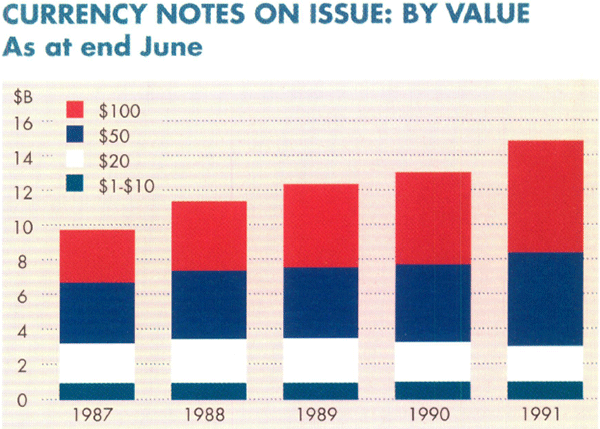
There has been little further shift towards the so-called “cashless society” over the past three decades: the community retains a strong demand for notes and coin. During the 1950s and first half of the 1960s, currency on issue grew less rapidly than GDP and the ratio of currency to GDP fell. Since then, currency has grown broadly in line with GDP and the ratio of currency to GDP has remained relatively stable.
During 1990/91, the Bank issued notes valued at $50 billion and received back notes valued at $48 billion; the total turnover of $98 billion was 1 per cent lower than in 1989/90.
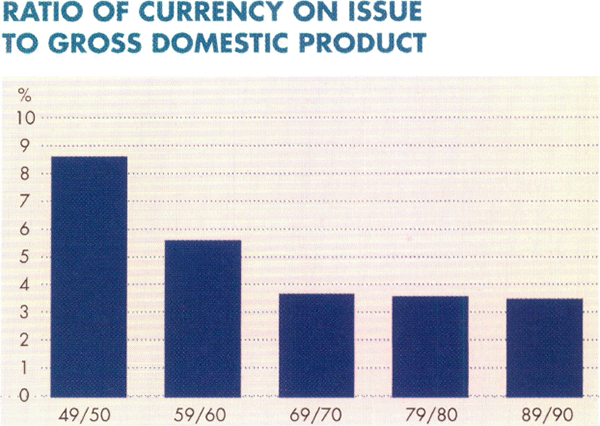
Reflecting concerns about the level and growth of currency note turnover through its accounts, the Bank has been discussing with banks and armoured car companies the scope for eliminating unnecessary movements of notes to and from the Bank. In August 1990, the arrangements under which armoured car companies are able to return notes directly to the Bank were changed to encourage greater recycling of notes in the private sector. The companies are now required as far as possible to use their own collections of notes to meet the requirements of their customers before drawing from or lodging with the Bank. This has had the effect of reducing their note turnover with the Bank by around 18 per cent.
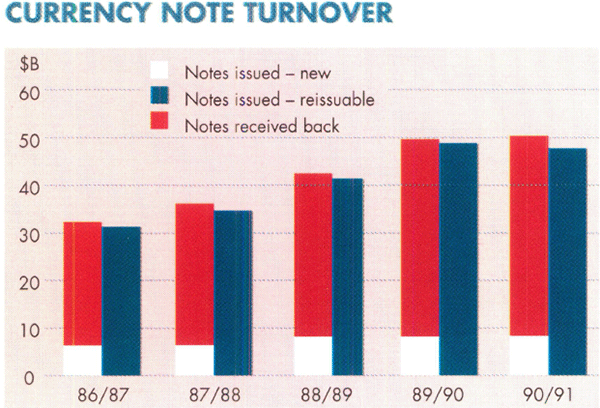
Notes that are surplus to the community's requirements, or which are soiled, are returned to the Bank. These notes are processed through high-speed automated equipment which counts and checks them for authenticity, sorts them according to fitness, packs those fit for re-issue and destroys the others. The Bank is arranging for this equipment to be upgraded in ways which will enhance sorting and checking for counterfeits. During 1990/91, the Bank processed some 1,525 million notes of which about 80 per cent were re-issued and the remainder destroyed. This was about four times the number of notes in active circulation during the year.
In May last year, the Bank announced that a new series of currency notes would be issued, commencing with the $5 note. As well as incorporating the latest security features to minimise the risk of counterfeiting, the new series will provide the opportunity to acknowledge the achievements of a number of famous Australian men and women not previously depicted on notes.